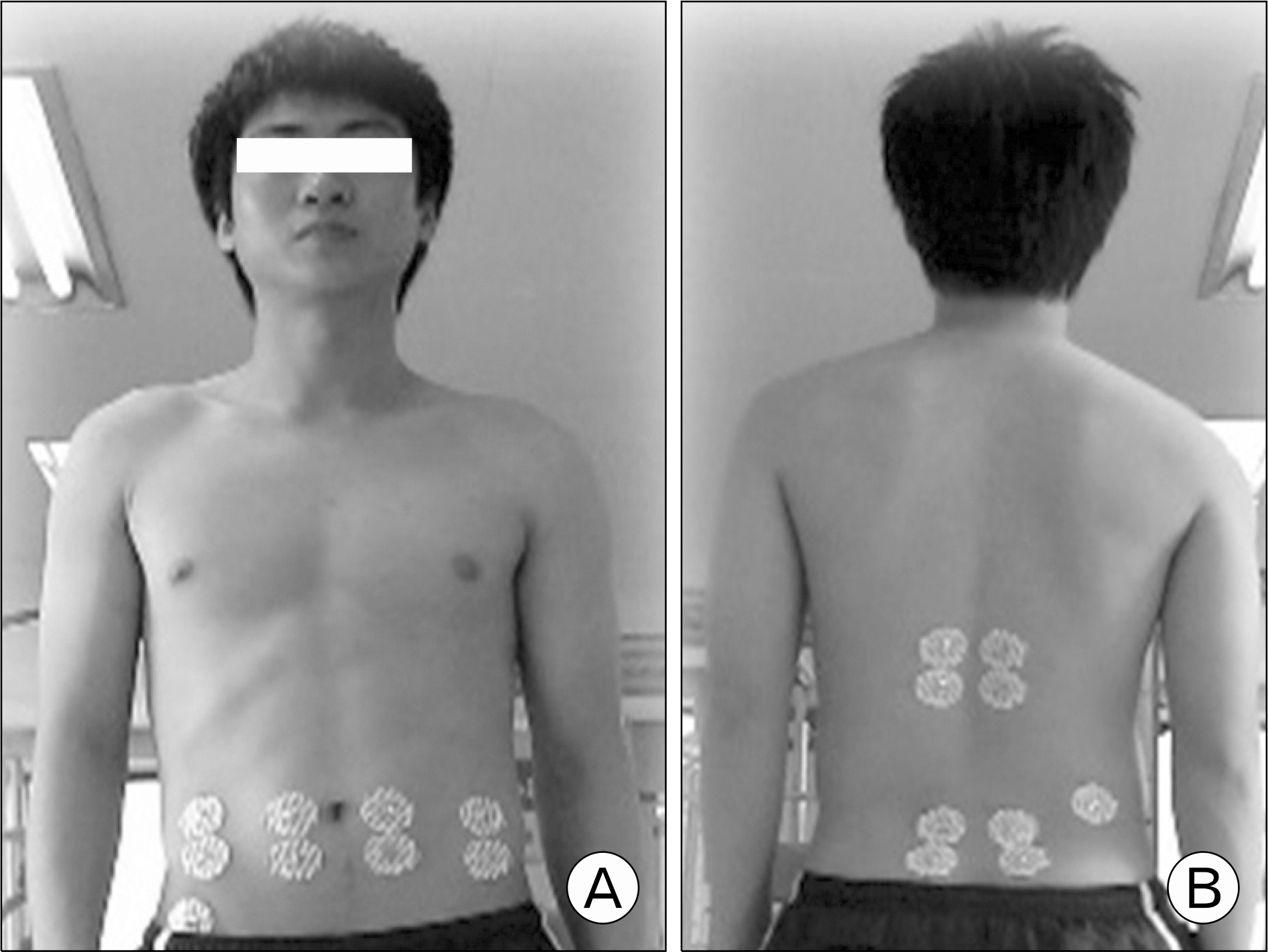Korean J Sports Med.
2019 Sep;37(3):84-93. 10.5763/kjsm.2019.37.3.84.
The Changes of Contraction Patterns in Trunk Muscles with Multidirectional Tilting Motion on the Dynamic Posturography
- Affiliations
-
- 1Research Center for Exercise and Sport Science, Daegu University, Gyeongsan, Korea. jlee@daegu.ac.kr
- KMID: 2456195
- DOI: http://doi.org/10.5763/kjsm.2019.37.3.84
Abstract
- PURPOSE
The aim of this study was to investigate the changes of contraction patterns and the differences of activities in trunk muscles during dynamic balance (multidirectional tilting exercise).
METHODS
Eight physically active male subjects participated in the study. Tilting exercises were included by four directions (i.e., forward, backward, left, and right side), and were undertaken at three different tilting degrees (i.e., 10°, 20°, and 30°). They performed two occasions of tilting exercise, separated by 6-week time interval. Surface electromyography system was used for record of any signals produced by muscles which normalized as percentage of maximum voluntary isometric contraction.
RESULTS
There were no statistically significant different interactive effects in any of muscles between two factors (time vs. degree). However, we identified significant main effects of degrees (among 10°, 20°, and 30°) in muscle activations during maintaining with forward tilting (left and right longissimus, multifidus), backward tilting (left and right rectus abdominis, external oblique), left side tilting (right rectus abdominis, external oblique, longissimus, multifidus), right side tilting (left rectus abdominis, external oblique, longissimus, multifidus).
CONCLUSION
Findings from this study allow the multidirectional tilting exercise to be considered as suitable for ameliorate muscle balance by inducing co-contraction in trunk muscles.
Keyword
Figure
Reference
-
References
1. Brachman A, Kamieniarz A, Michalska J, Pawlowski M, Slomka KJ, Juras G. Balance training programs in athletes: a systematic review. J Hum Kinet. 2017; 58:45–64.2. Liebenson C. Sensory-motor training. J Bodyw Mov Ther. 2001; 5:21–7.3. Hubley-Kozey CL, Vezina MJ. Muscle activation during exercises to improve trunk stability in men with low back pain. Arch Phys Med Rehabil. 2002; 83:1100–8.
Article4. Hrysomallis C, McLaughlin P, Goodman C. Relationship between static and dynamic balance tests among elite Australian Footballers. J Sci Med Sport. 2006; 9:288–91.
Article5. Gildea JE, Hides JA, Hodges PW. Size and symmetry of trunk muscles in ballet dancers with and without low back pain. J Orthop Sports Phys Ther. 2013; 43:525–33.
Article6. Winter DA. Human balance and posture control during standing and walking. Gait Posture. 1995; 3:193–214.
Article7. Lee HH, Hwang JH, Kim YB, et al. Perception of balance training and evaluation. Korean J Sports Med. 2012; 30:23–33.
Article8. Bronstein AM. Postrography. Luxon L, Furman JM, Martini A, Stephens D., editorsTextbook of audiological medicine: clinical aspects of hearing and balance. London: Martin Dunitz;2003. p. 747–58.9. Nashner LM, Peters JF. Dynamic posturography in the diagnosis and management of dizziness and balance disorders. Neurol Clin. 1990; 8:331–49.
Article10. Won M, Kim M, Kim S, Lee J. The effect of visual information provision on the changes of electromyogram activity in trunk and lower leg muscles during dynamic balance control. Korean J Sports Med. 2014; 32:44–54.
Article11. De Luca CJ. The use of surface electromyography in biomechanics. J Appl Biomech. 1997; 13:135–63.
Article12. Martuscello JM, Nuzzo JL, Ashley CD, Campbell BI, Orriola JJ, Mayer JM. Systematic review of core muscle activity during physical fitness exercises. J Strength Cond Res. 2013; 27:1684–98.
Article13. Akuthota V, Nadler SF. Core strengthening. Arch Phys Med Rehabil. 2004; 85(3 Suppl 1):S86–92.14. Alexandrov AV, Frolov AA, Horak FB, Carlson-Kuhta P, Park S. Feedback equilibrium control during human standing. Biol Cybern. 2005; 93:309–22.
Article15. Hides J, Stanton W. Muscle imbalance among elite Australian rules football players: a longitudinal study of changes in trunk muscle size. J Athl Train. 2012; 47:314–9.
Article16. Franettovich M, Hides J, Mendis MD, Littleworth H. Muscle imbalance among elite athletes. Br J Sports Med. 2011; 45:348–9.
Article17. Zazulak BT, Hewett TE, Reeves NP, Goldberg B, Cholewicki J. Deficits in neuromuscular control of the trunk predict knee injury risk: a prospective biomechanical-epidemiologic study. Am J Sports Med. 2007; 35:1123–30.18. Butcher SJ, Craven BR, Chilibeck PD, Spink KS, Grona SL, Sprigings EJ. The effect of trunk stability training on vertical takeoff velocity. J Orthop Sports Phys Ther. 2007; 37:223–31.
Article
- Full Text Links
- Actions
-
Cited
- CITED
-
- Close
- Share
- Similar articles
-
- Postural Control in the Patients with Chronic Tension-Type Headache
- Quantitative Electromyographic Analysis of Scalenus Medius and Upper Trapezius Muscles during Neck Motion
- Neer's Inferior Capsular shift for Involuntary Inferior and Multidirectional Instability of the Shoulder
- Effect of Forward and Backward Arm Extension Movement of Pilates Exercise Using Cadillac Instrument on Trunk Muscle Activity
- Changes in Shoulder Muscle Activities Depending on Static and Dynamic Body Positions during Shoulder External Rotation Exercises Using Kinetic Chain Concept



